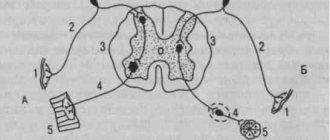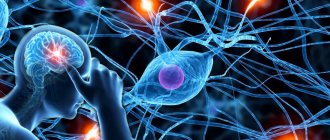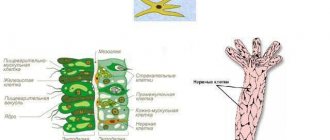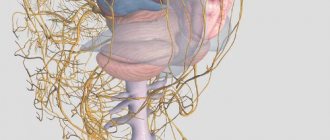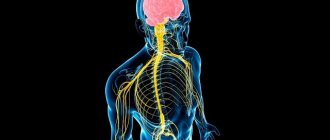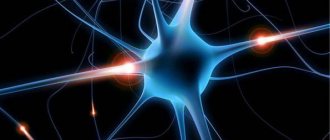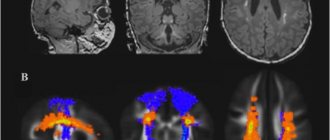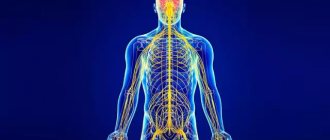Everyone has somatoform, but not everyone knows where and why. Often you have to meet with patients who are in pain, and doctors treat them and treat them, but cannot cure them. This happens. Why? There are probably many reasons, but let’s focus on one – somatoform.
If this word is translated, we get the interesting term “corporeal.” What could it mean? This means some symptoms that manifest themselves in the sphere of somatics (body), but have their roots in the sphere of the psyche. They seem to imitate the symptoms of somatic diseases (that’s why somato
shaped,
somato
-shaped), but in fact they are not. True, this is a simplified view. Now let's try to figure it out in more detail.
So, our psyche is connected with our somatics (body). This communication occurs primarily through the autonomic nervous system (ANS). Everyone has this system, and thanks to its action we can observe changes in somatics against the background of changes in the psyche. Fine. For example, when we are nervous, our pulse and blood pressure increase, sweating, breathing (“breath stole from the goiter”), bowel function (“bear sickness”), etc. are impaired. This, I repeat, is observed normally in any person.
But sometimes it happens that these somatic manifestations are too pronounced or atypical. Then we say that there is something wrong with our ANS - it is not working as it should. In this case, it is appropriate to talk about VSD - vegetative-vascular dystonia. The modern classification of diseases allows such a diagnosis to be made in isolation - this happens. However, in practice, we most often observe vegetative-vascular dystonia in combination with other diseases - this also happens.
Below I propose to consider what situations there may be when we may encounter bodily (somatic) manifestations of mental dysfunction.
Vegetovascular dystonia
VSD is vegetative-vascular dystonia, or the so-called “somatoform dysfunction of the ANS” according to the latest IBC (International Classification of Diseases). That is, the tone of the ANS is disturbed, loose. A person does not have any serious illnesses, but various somatic symptoms (see above) appear, especially against the background of stress, strain, etc.
What to do?
Of course, get treatment. Be treated by a neurologist and, possibly, a psychotherapist. If necessary, take vegetative stabilizers or mild sedatives. Unfortunately, as practice shows, doctors of therapeutic specialties are not always able to competently prescribe treatment for such a patient (or even simply explain his condition). As a result, the patient goes to doctors and ends up in one of two unpleasant situations. Either they tell him that he is healthy and there is nothing to invent here, or they endlessly search for, find and treat various incomprehensible diseases, as a result of which money and time are wasted, but the condition does not improve.
Depending on the height of the “balcony”
With pathology of the central parts of the autonomic nervous system (suprasegmental or segmental), disorders of the regulation of body activity of the VSD class develop (vegetative dystonia, also called autonomic dysfunction or autonomic neurosis).
Involvement of the hypothalamic centers leads to the occurrence of hypothalamic syndrome, combined damage to the hypothalamic and limbic centers leads to selective disorders in the regulation of vascular trophism - angiotrophoneurosis.
As a result of subarachnoid hemorrhage (the outcome of an aneurysm of the anterior communicating artery); tumors (gliomas); traumatic brain injury; a hereditary disease with damage to the hypothalamus, in adults there are disruptions in the regulation of body temperature, in its nutrition (expressed as obesity or anorexia nervosa), as well as circadian rhythm disorders and sexual dysfunction of central origin.
In children, the described disorders manifest themselves:
- Prader-Willi syndrome (a combination of hypogonadism and mild mental retardation with obesity and muscle hypotonicity);
- Kleine-Levin syndrome (drowsiness and bulimia against the background of youthful hypersexuality);
- development of craniopharyngioma .
Psychosomatic diseases
Psychosomatic diseases are diseases for which mental disorders are one of the factors in the development of the disease. Not the only reason, but one of the factors. Psychosomatic diseases include most chronic diseases - coronary heart disease (CHD), hypertension (HTN), peptic ulcer (PU), psoriasis, bronchial asthma. When a person experiences constant stress, hassle, tension, the risk of developing these diseases is higher. And if they have already developed, then the risk of exacerbations is higher.
What to do?
Avoid stress (which, alas, is not always possible in our lifetime). If a diagnosis is made, you need to be treated by a therapist (cardiologist, gastroenterologist, etc.) and follow the recommendations of this specialist. If necessary (constant or long-term unstable emotional state), consult a psychotherapist. You may need to take sedatives.
Somatoform dysfunction in colors and sounds
Cardialgia syndrome is the most common and significant in the structure of SVD with a cardiovascular “inclination”. It differs from true cardialgia by pronounced motor restlessness, expressive moans and “groaning”, but the pain itself is not associated with physical activity and lasts from hours to days.
The number of beats during a heartbeat does not exceed 110-120 per minute, increasing at rest and in a supine position; Blood pressure may briefly rise to 150/90-160/95 mm Hg art. under stress. The effect of taking tranquilizers is greater than that of antihypertensive drugs.
Dysphagia syndrome in SVD is clearly associated with psychological trauma, accompanied by pain in the chest, solid food is easier to swallow due to neurotic spasm of the esophagus. Gastralgia is unstable, not associated with food intake; characterized by aerophagia and hiccups, reminiscent of a cock's crow, which usually manifests itself defiantly in a crowded place.
The respiratory system with somatoform dysfunction of the autonomic nervous system reacts to stress with laryngospasm and choking, which are subsequently provoked by situations that are traumatic to the psyche, as well as the appearance of shortness of breath and a feeling of incomplete inspiration (especially in a confined space), which do not manifest themselves in sleep.
Despite the “dramatic” nature of the situation, pneumotachometry indicators do not reveal symptoms of pulmonary heart failure, although SVD continues for a long number of years.
Urogenital manifestations of SVD are pollakiuria, which appears exclusively when there is no toilet nearby, and “urinary stuttering,” a psychogenic retention of urination in the presence of others. Laboratory and instrumental diagnostics do not reveal pathology in these cases.
Persistent visits by patients to a rheumatologist are associated with prolonged unexplained low-grade fever, combined with hyperpathies of the extremities, but in this situation they are volatile, unstable, independent of weather, physical activity and are clearly associated with the stress experienced.
Diseases of the central nervous system
Organic diseases of the central nervous system
. Such diseases in which the integrity and normal structure of tissues in the central nervous system are disrupted. These can be serious illnesses (for example, multiple sclerosis). These may also be changes due to vascular disorders (which accumulate with age in any person), previous head injuries, neuroinfections, and alcohol consumption. Why are we mentioning them here? Because these neurological disorders are necessarily accompanied by disturbances in the mental and emotional sphere, including somatoform symptoms. In this case, the diagnosis of VSD will not be a mistake, but it would be more correct to consider dysfunction in the VNS as part of a general disorder of the nervous system.
What to do?
Also receive treatment, primarily from a neurologist, and, if necessary, from a psychotherapist. Abroad, there is a practice of regularly supporting the nervous system of a person who has reached a certain age with the help of drugs - this slows down the aging process and helps preserve cognitive functions (memory, attention, intelligence). We don't do that. Although almost any elderly person, especially an old person, due to age, has organic disorders in the central nervous system (CNS), and as a result experiences symptoms such as memory impairment (especially for recent events - where did you put what, why did you go, etc. ) and attention, disturbances in thinking (which is manifested by obsessive thoroughness, verbosity of speech, fixation on unimportant details and the inability to separate the secondary from the main), disturbances in the emotional sphere (touchiness, stuck affect, fluctuations in affect, irritability and tearfulness at the slightest provocation), sleep disturbances and other. We generally consider all this to be symptoms of old age and there is nothing to do, the neurologist at the clinic will say: “What do you want?! Age” – and throws up his hands. Yes, it’s true, these processes are a consequence of aging, but with the help of well-chosen treatment they can be slowed down and partially inhibited.
Classified as F45.3, or there is such dysfunction!
Patients who make up the group of diseases designated by the term “somatoform dysfunction of the autonomic nervous system” (ICD 10 code F45.3) are of two types:
- The first bases complaints of a general neurotic nature on objectively existing signs of vegetative tension: heartbeat, redness of the skin and increased sweating, hand tremors, expressing fear for a violation of the health of a specific system or organ, for the pathology of which these manifestations are uncharacteristic.
- The second type , which also connects the manifestations of its physiology (fever, fatigue, short-term bloating, etc.) with a specific organ (system), cannot present anything specific: everything hurts, now here, now there. But its sensations are fleeting and subjective in nature, not confirmed either physically or instrumentally, while the existing minor deviations in the operation of the “suspicious” system fall within the limits of its natural physiological functioning.
Somatic symptoms of mental illness
Different mental illnesses may have different body discomforts or symptoms. Sometimes such a patient may believe that he has some kind of incomprehensible somatic disease and go to doctors endlessly, trying to find its cause. Most often, somatoform symptoms occur against the background of increased general anxiety. Signs of this are constant obsessive worries on various topics (primarily about health), internal tension (which can manifest itself as a feeling of tightness, tension, “like a lump in the chest,” a feeling of difficulty breathing, tremors of the limbs or the whole body).
What to do?
Of course, get treatment again! If a patient has an abundance of somatic complaints, but doctors of somatic specialties cannot explain his condition, he should definitely consult a psychotherapist, because this means that the cause is in the sphere of the psyche. If somatic complaints are accompanied by obvious disturbances in the emotional sphere, this is also a reason to consult a psychotherapist.
In order to understand how strong bodily changes can occur against the backdrop of purely mental causes, we can give several striking examples.
False pregnancy
A woman really wants to get pregnant, but she can’t. If she strongly believes that she is pregnant, then her periods may stop, her mammary glands may swell, and her belly may even begin to grow (due to the subcutaneous tissue).
Hysterical blindness, deafness, paralysis
Hysterical blindness, deafness, paralysis are functional disorders that are indistinguishable from organic ones, but do not have a somatic cause (because it lies in the sphere of the psyche). Unlike organic conditions, they can be “cured” with the help of magic, extrasensory perception, prayer, touching holy relics, etc. In this case, a non-existent disease will be cured using a non-existent method. These are also facts, and they also have a simple explanation.
Hypocrisy, measuring, demonic possession, falling sickness, etc.
“Mental epidemics” of the past (cliques, hypocrisy, demonic possession, falling sickness, etc.) - when a large number of people experienced similar fanciful symptoms. Moreover, the reason is also in the sphere of the psyche, and not somatics, i.e. There is no objective, physical disease in the body.
Curses
Curses of African (or other) shamans. The shaman points his finger at his fellow tribesman and says “Boo!” - and he dies a day or two later. Does not affect members of another tribe, as well as white people, because they do not believe in the power of this shaman or do not believe in fairy tales at all. This phenomenon is not a reliable fact. But there is no data that would say that this is theoretically impossible. A person believes in a curse (mental process), as a result of this and without any other reasons, irreversible somatic changes (even lethal) occur. The topic is interesting and, without a doubt, needs further research.
Vegetative-vascular dysfunction
The “technology” of VSD is extremely simple: a frightening and traumatic life situation, which is a source of nervous overload, is displaced by the psyche into the subconscious, giving rise to a neurotic “trail”, in the field of which the internal organs fall, and a picture is formed that imitates the symptoms of a serious somatic pathology.
Extraordinarily conducive to it:
A characteristic feature of VSD is alexithymia – the inability to verbally describe one’s emotional experiences.
Most often, VSD “mimics” one of the syndromes:
- cardiovascular (cardiovascular);
- hyperventilation syndrome;
- irritable bowel syndrome;
- hyperhidrosis;
- cystalgic;
- sexual dysfunction;
- thermoregulation disorders;
- or simulates a cumulative “defeat” of several systems.
Differentiation in the diagnosis of SVD
The most important differential diagnostic criteria for somatoform dysfunction of the autonomic nervous system should be the presence in patients of anxiety-phobic or other anxiety disorders, manifested by:
- in the presentation and repetition of many complaints with an emphasis on pain of a long and multiple nature in an insistent, demanding, and - at the same time - sad and tragic presentation;
- in turning to doctors of various specialties with categorical disbelief in the help of medicine;
- in the requirement to conduct repeated (including invasive) studies;
- the impossibility of convincingly substantiating the patient’s complaints with an already established, diagnosed disease;
- the patient’s categorical disbelief in the absence of an organic cause for pain, in the inconsistency of the somatic picture with the complaints presented, on the one hand, and: “experience” of the disease of at least 2 years when the patient is under 30 years of age, as well as the lack of family or social adaptation, on the other.
When differential diagnosis with generalized anxiety disorder, take into account:
- the severity of sensations from the disease in SVD;
- their constancy;
- the patient’s persistent adherence to the opinion of pathology in a certain organ or system.
Treatment of ADHD
Treatment tactics for somatoform dysfunction of the autonomic nervous system are determined individually, taking into account clinical manifestations. Mandatory conditions are systematicity, complexity and duration of therapy. They carry out health measures, normalize work and rest schedules, select a diet, recommend maintaining moderate physical activity and, if possible, avoiding stress. They use vitamins, adaptogens, vegetative stabilizers, nootropics and means to improve cerebral circulation. Carry out symptomatic therapy. If necessary, antidepressants and sedatives are prescribed. A patient with somatoform dysfunction of the autonomic nervous system is referred to individual and group psychotherapy.
General information
ADHD is a disorder manifested by signs of damage to one or more organs in the absence of an organic basis for the appearance of such symptoms, according to objective studies. Pathological manifestations arise from organs whose activity is completely or largely regulated by the autonomic nervous system. They can imitate somatic pathology, but more often they differ from it in vagueness, variability and an abundance of complaints with minor external manifestations.
Somatoform dysfunction of the autonomic nervous system is a common disease. In ICD-10 it is included in the group of neurotic disorders. Violations usually arise or worsen under the influence of acute stress and chronic traumatic situations, and can be persistent, permanent, or manifest themselves in the form of paroxysms. The disorder is not life-threatening and does not cause deterioration in physical health, but it can impair work ability and cause serious inconvenience to patients. Treatment for ADHD is carried out by specialists in the field of neurology, clinical psychology and psychotherapy.
Classification
There are three types of somatoform dysfunction: with a predominance of the activity of the sympathetic nervous system, with a predominance of the activity of the parasympathetic nervous system, and mixed. A stable or paroxysmal course is possible. In a stable course, phases of exacerbation and remission are observed; in paroxysmal cases, sympathoadrenal, vagoinsular and mixed crises are observed. There are three degrees of severity of somatoform dysfunction of the autonomic nervous system: mild, moderate and severe. Depending on the predominant manifestations, SDVNS is distinguished:
- of cardio-vascular system
- upper gastrointestinal tract
- lower gastrointestinal tract
- respiratory organs
- urinary system
- other organs and systems
What does modern medicine offer?
The patient - for all his negative attitude towards medicine - will definitely be treated. For, having experienced a series of crises that are of a sympathoadrenal, vagoinsular, or parasympathetic nature, he quickly realizes that he himself cannot cope with his “rebellious” nature.
The prognosis that 90% of patients experience a positive effect after treatment is encouraging.
The first “pillar” is measures to “root” the patient in the family and society, and here it is impossible to do without rational psychotherapy. But it is important to reassure the patient by explaining that this is not the same as treating schizophrenia.
Normalization of the work regime, rest during work and at night, rational nutrition and its culture, enrichment of food with necessary microelement supplements (especially magnesium and potassium) is the second condition for the success of treatment.
There is also no way to bypass basic physical education - physical inactivity aggravates cerebral ischemia.
The choice of drug treatment should take into account the predominant type of autonomic reactions (vagotonic, sympathicotonic, mixed).
The first-line drugs of choice include a group of antidepressants (especially the tricyclic class and the SSRI group), the second - substances of the class of beta-blockers and mood stabilizers.
In the first stages of treatment, a combination of antidepressant + benzodiazepine is advisable; A means of reserve for a significant level of anxiety that is not relieved by Benzodiazepine is antipsychotic drugs with a sedative effect.
In the treatment of SVD, treatment is enhanced by drugs of the nootropic, vasoactive and vegetative stabilizing groups.
Herbal medicine also makes an equally significant contribution to the restoration of the patient’s psychophysical health.
For the parasympathicotonic type of disorder, the following drugs will be useful:
- ginseng;
- aralia;
- lures;
- Leuzea;
- Eleutherococcus;
- lingonberries;
- bearberry;
- juniper.
The following components should be used for sympathicotonic or mixed types of disorders in the actions of the autonomic nervous system:
